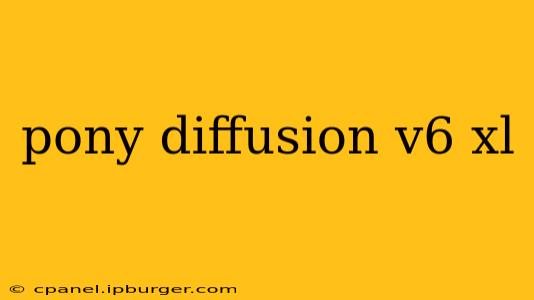Stable Diffusion, the revolutionary open-source image generation model, continues to evolve. The latest iteration, Pony Diffusion v6 XL, represents a significant leap forward in both image quality and creative possibilities. This detailed analysis explores the advancements, key features, and potential applications of this powerful AI art generator.
What Makes Pony Diffusion v6 XL Different?
Pony Diffusion v6 XL builds upon the strengths of previous Stable Diffusion models while addressing some key limitations. The "XL" designation points to a significant increase in model size and training data, leading to several notable improvements:
-
Enhanced Image Resolution and Detail: Expect sharper images with significantly improved detail and clarity compared to its predecessors. Fine details, previously difficult to render accurately, are now handled with greater finesse. This makes it ideal for generating highly detailed artwork and intricate designs.
-
Improved Coherence and Consistency: One of the challenges with earlier Stable Diffusion models was occasional inconsistencies within generated images. Pony Diffusion v6 XL boasts enhanced coherence, resulting in more realistic and believable outputs. This is particularly beneficial for generating complex scenes or images requiring intricate details across the entire canvas.
-
Increased Style Variety and Control: The expanded training data provides a broader range of artistic styles accessible to the user. This increased stylistic control empowers creators to experiment with various aesthetics, seamlessly blending different influences into their artwork.
-
Faster Inference Times (Potentially): While model size usually correlates with slower inference, advancements in optimization techniques may have mitigated this effect. While definitive benchmarks require rigorous testing, early reports suggest relatively improved speed compared to previous, similarly large models.
Applications of Pony Diffusion v6 XL
The capabilities of Pony Diffusion v6 XL open doors to a wide range of applications:
-
Digital Art Creation: From concept art and illustrations to intricate digital paintings, the model serves as a powerful tool for artists of all skill levels.
-
Game Asset Creation: Generating high-quality textures, characters, and environments significantly accelerates game development pipelines.
-
Product Design and Visualization: Quickly visualize and prototype product designs, aiding in the iterative design process.
-
Architectural Visualization: Create photorealistic renderings of architectural designs, assisting architects and clients in visualizing proposed structures.
-
Marketing and Advertising: Generate visually compelling assets for marketing campaigns, saving time and resources.
Limitations and Considerations
While Pony Diffusion v6 XL offers significant advancements, it's important to acknowledge some limitations:
-
Computational Resources: The larger model size requires substantial computing power for optimal performance. Users will need robust hardware (high-end GPUs) to generate images efficiently.
-
Ethical Concerns: As with all AI image generation tools, ethical considerations surrounding copyright, intellectual property, and the potential for misuse remain paramount. Responsible use and understanding of the technology's implications are crucial.
-
Potential for Bias: While developers strive to mitigate bias, datasets used to train AI models can inadvertently reflect existing societal biases. Users should be aware of these potential biases and critically evaluate the generated outputs.
Conclusion: The Future of Stable Diffusion
Pony Diffusion v6 XL marks a substantial step forward in the evolution of Stable Diffusion. Its enhanced capabilities and improved performance open exciting new possibilities for creative professionals and enthusiasts alike. However, responsible use and a thorough understanding of its limitations are essential to harness its full potential while navigating the ethical considerations inherent in AI image generation technology. As the technology continues to evolve, we can anticipate even more powerful and versatile iterations in the future.
